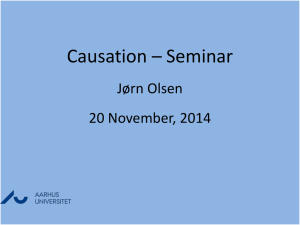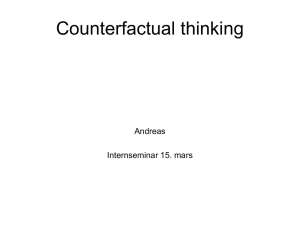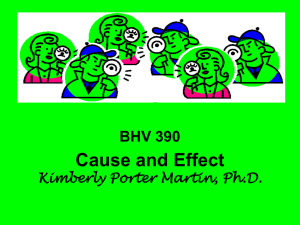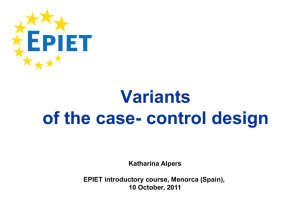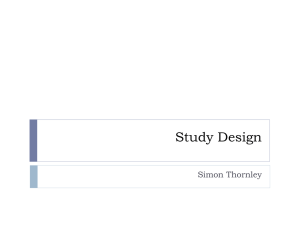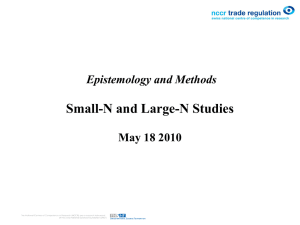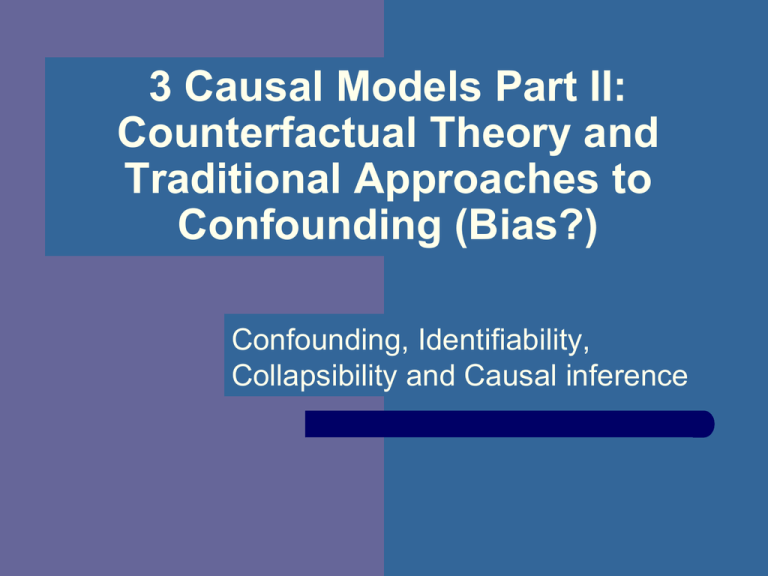
3 Causal Models Part II:
Counterfactual Theory and
Traditional Approaches to
Confounding (Bias?)
Confounding, Identifiability,
Collapsibility and Causal inference
Thursday reception at lunch time
at SACEMA
Review Yesterday
Causes – definition
Sufficient causes model
–
–
–
Component causes
Attributes
Causal complements
Lessons
–
–
–
–
Disease causation is poorly understood
Diseases don’t have induction periods
Strength of effects determined by prevalence of complements
Only need to prevent one component to prevent disease
This Morning
Counterfactual model
–
–
Susceptibility types
Potential outcomes
Confounding under the counterfactual
susceptibility model of causation
Stratification
–
–
Identifying confounders
Standardization versus pooling
What is Confounding?
Give me the definition
you were taught or
describe how you
understand it
What is an “adjusted”
measure of effect?
Is red wine cardio-protective?
In an adjusted model to remove
confounding of the E-D relationship,
is it reasonable to remove variables
that are not statistically significant
and include those that are?
Counterfactual Theory
Potential Outcomes,
Susceptibility types
Poor Clare
Doctor prescribes
antibiotics
3 days later she is
cured
Did the antibiotic
cure her?
Cinema d’Counterfactual
The counterfactual model:
The counterfactual ideal
Disease experience,
given exposed
Hypothetical disease
experience, if
unexposed
The
Counterfactual
Ideal
Counterfactual theory
Only one can actually be observed
–
Ask, what would have happened had things
been different, all other things being equal?
–
The other is “counterfactual” in that it is counter to
what is actually observed
Leads to the causal contrast
Exposure must be changeable to have
effect
–
We will come back to this
The counterfactual model:
The counterfactual ideal
Approximation to
The Counterfactual
Ideal
Disease experience,
given exposed
Substitute disease
experience of truly
unexposed
Take home message 1:
We’re often interested in what happens
to index (exposed). Reference
(unexposed) are useful only insofar as
they tell us about index group.
Must Specify a Causal Contrast
Events are not causes themselves
–
Only causes as part of a causal contrast
What is the effect of oral
contraceptives on risk of death?
–
The question, as defined, has no meaning
Compared
–
to condoms, increased risk
Through stroke and heart attack
Compared
to no contraceptive, maybe
decreased risk
–
Some places childbirth may be a greater risk
Take home message 2:
“Effects” of exposures only have
meaning when defined in contrast
to an alternative
If ethics were not a concern, how
would you design an RCT of
smoking and lung cancer?
Think about dose,
duration
What about obesity and MI?
What about gender
and cancer?
Effects Must be Amenable to Action
To have an effect, must be changeable
–
–
What is effect of sex on heart disease?
How would you change sex?
Defining the action helps define the
causal contrast well
–
–
What is the effect of obesity on death?
How would you change obesity?
Each has a different effect, some good, some bad
To remind us, use A for Action, not E
Take Home Message 3:
For etiologic observational studies,
think of RCT you would do first.
Develop your observational study
with the RCT in mind.
Think of the action,
inclusion criteria, the
placebo, etc.
To identify a causal effect in an
individual
Need three things:
–
Call the counterfactual outcomes:
–
Ya=1 vs Ya=0, read: Y that would occur if A=a
Note counterfactuals different from:
–
Outcome, actions compared, person whose
2+ counterfactual outcomes compared
Y|A=1 (or just Y), read: Y given A=1
Effect can be precisely defined as:
–
Ya=1 ≠Ya=0
Assume infinite population with
no information or selection bias, a
dichotomous A and Y
All examples, assume
each person represents
1,000,000 people exactly
the same as them so no
random error problem
Assume each person represents 100,000 people
Person A
Person B
A (E)
1
1
Ya=1
1
1
Ya=0
0
1
Y
1
1
Person C
Person D
Person E
1
1
0
0
0
0
1
0
0
0
0
0
Person F
Person G
Person H
0
0
0
1
1
0
0
1
1
0
1
1
Effect : [Pr(Ya=1=1) - Pr(Ya=0=1)] =
Assume each person represents 100,000 people
Person A
Person B
A (E)
1
1
Ya=1
1
1
Ya=0
0
1
Y
1
1
Person C
Person D
Person E
1
1
0
0
0
0
1
0
0
0
0
0
Person F
Person G
Person H
0
0
0
1
1
0
0
1
1
0
1
1
Effect : [Pr(Ya=1=1) - Pr(Ya=0=1)] = [4/8 – 4/8] = 0
Association : [Pr(Y=1|A=1) - Pr(Y=1|A=0)] =
Assume each person represents 100,000 people
Person A
Person B
A (E)
1
1
Ya=1
1
1
Ya=0
0
1
Y
1
1
Person C
Person D
Person E
1
1
0
0
0
0
1
0
0
0
0
0
Person F
Person G
Person H
0
0
0
1
1
0
0
1
1
0
1
1
Effect : [Pr(Ya=1=1) - Pr(Ya=0=1)] = [4/8 – 4/8] = 0
Association : [Pr(Y=1|A=1) - Pr(Y=1|A=0)] = [2/4 – 2/4] = 0
The counterfactual model
Susceptibility types
Susceptibility
Type
Envision 4
responses to
exposure, relative to
unexposed
–
–
–
–
Type 1 - Doomed
Type 2 - E causal
Type 3 - E preventive
Type 4 - Immune
CST: Counterfactual
susceptibility type
Exposed
Outcome
(Ya=1)
Unexposed
Outcome
(Ya=0)
Type 1 –
doomed
1
1
Type 2 –
E causal
1
0
Type 3 –
E preventive
0
1
Type 4 –
immune
0
0
The counterfactual model
The index condition, relative to the
reference condition, affects only
susceptibility types 2 and 3
–
–
Types 2 get the disease, but would not get disease
had they had the reference condition
Types 3 do not get the disease, but would have got
the disease had they had the reference condition
Individual Susceptibility under the
CST model
Individual
Susceptibility
Risk Difference Risk Ratio
Ya=1 – Ya=0
Ya=1 / Ya=0
Type 1
1–1=0
1/1=1
Type 2
1–0=1
1 / 0 = undef
Type 3
0 – 1 = -1
0/1=0
Type 4
0–0=0
0 / 0 = undef
Can type 2 and 3 co-exist?
Are there exposures that can both prevent
and causes disease?
–
–
–
–
Vaccination and polio
Exercise and heart attack
Seat belts and death in a motor vehicle accident
Heart transplant and mortality
So what does RD = 0 or RR=1 mean?
–
–
–
Could mean no effect
Could be balance of causal/preventive mechanisms
We call no effect “sharp null” but it is not identifiable
Take home message 4:
If exposures can be causal and
preventive, estimates of effect only tell
us about the balance of causal and
preventive effects
Average causal effects
Individual effects rarely identifiable
because we don’t have both conditions
–
But average causal effects may be
identifiable in populations
An average causal effect of treatment A
on outcome Y occurs when:
–
–
Pr(Ya=1 = 1) ≠ Pr(Ya=0 = 1)
Or more generally, E(Ya=1) ≠ E(Ya=0)
Note
makes no reference to relative vs. absolute
Effects vs. Associations
Effects measures
–
–
–
RD: Pr(Ya=1 = 1) - Pr(Ya=0 = 1)
RR: Pr(Ya=1 = 1) / Pr(Ya=0 = 1)
OR: Pr(Ya=1 = 1)/Pr(Ya=1 = 0)/
Pr(Ya=0 = 1)/Pr(Ya=0 = 0)
Associational measures
–
–
–
RD: Pr(Y = 1|A=1) - Pr(Y = 1|A=0)
RR: Pr(Y = 1|A=1) / Pr(Y = 1|A=0)
OR: Pr(Y = 1|A=1) / Pr(Y = 0|A=1) /
Pr(Y = 1|A=0) / Pr(Y = 0|A=0)
Traditional Approaches to
Confounding and Confounders
Extend the CST model of causation to
populations
Susceptibility
Type
Index
Outcome
Reference
Outcome
Proportion
in
Index Pop
Proportion
in
Reference Pop
Type 1 –
doomed
1
1
p1
q1
Type 2 –
index causal
1
0
p2
q2
Type 3 –
index
preventive
0
1
p3
q3
Type 4 –
immune
0
0
p4
q4
1
1
What is the risk of disease in exposed?
Susceptibility
Type
Type 1 –
doomed
Index
Outcome
Observed
Reference
Outcome
risk
in
exposed is p1 + p2,
but we
1 cannot tell
1
how many of each
Proportion
in
Index Pop
Proportion
in
Reference Pop
p1
q1
Type 2 –
index causal
1
0
p2
q2
Type 3 –
index
preventive
0
1
p3
q3
Type 4 –
immune
0
0
p4
q4
1
1
What would the risk of disease be in the
exposed had they been unexposed?
Susceptibility
Type
Index
Outcome
Reference
Outcome
Counterfactual risk
is the risk the
Type 1 –
1
1
doomed
exposed would
have had had they
Type 2 –
1
0
index causalbeen exposed:
p1+p3
Type 3 –
index
preventive
Type 4 –
immune
Proportion
in
Index Pop
Proportion
in
Reference Pop
p1
q1
p2
q2
0
1
p3
q3
0
0
p4
q4
1
1
When can reference group stand in for
the exposed had they been unexposed?
To
have a valid
comparison,
Susceptibility
Index
Reference
Typerequire
Outcome
Outcome
we
the disease
experience of reference
Type 1 – be able to stand in for
group
1
1
doomed
the counterfactual risk. This
Type
2–
is partial
exchangeability
1
0
index causal
Proportion
in
Index Pop
Proportion
in
Reference Pop
p1
q1
p2
q2
Type 3 –
index
preventive
0
1
p3
q3
Type 4 –
immune
0
0
p4
q4
1
1
Exchangeability
Observed
Counterfactual
Full exchangeability means the two
groups can stand in for each other
–
Risk exposed had = risk unexposed would
have had if they were exposed
Pr(Ya=1=1|A=1)
–
= Pr(Ya=1=1|A=0)
Risk unexposed had = risk exposed would
have had if they were unexposed
Pr(Ya=0=1|A=1)
= Pr(Ya=0=1|A=0)
Exchangeability
Observed
Counterfactual
Partial exchangeability means the E- can
stand in for what would have happened to
the E+ had they been unexposed
– Risk unexposed had = risk exposed would
have had if they were unexposed
Pr(Ya=0=1|A=1)
= Pr(Ya=0=1|A=0)
Take Home Message 5:
The unexposed have to be able to
stand in for the exposed had they been
unexposed. Not vice versa.
Partial
exchangeability
Two possible definitions of no
confounding (1)
Definition One — the risk of disease due to
background causes is equal in the index and
reference populations
p1
So p11 = q11 under this definition.
The risk difference [(p1 + p2) - (q1 + q3)]
equals (p2
assuming partial
p2 –- qq3),
3
exchangeability.
But effect should be based only on exposed
Two possible definitions of no
confounding (2)
Definition Two -- the risk of disease in the
reference population equals the risk the
index population would have had, if they had
been unexposed
p1 + p3
p1 ++ pp3
So p1
+3qunder this definition.
3 ==qq1
1+ q
The risk difference [(p1 + p2) - (q1 + q3)]
equals (p2
p2 –- p3
p3 ), assuming partial
exchangeability.
NOTE that RD related to balance of p2 and p3
We choose the second definition
First forces inclusion of effect of
absence of exposure in reference group
Second measures effect of exposure
only in index group
–
–
Holds under randomization
However, it is counterfactual
If exposure is never preventive, they
are same
We choose the second definition
A measure of association is
unconfounded if:
–
Experience of the reference group = the
disease occurrence the index population
would have had, had they been unexposed
Risk difference tells about balance of
causal/preventive action in index
–
Effect, not an estimate
To put it mathematically
Suppose we have two populations A and B
We want to observe: IAE+ - IAEWe observe: IAE+ - IBEIf we add IAE- - IAE- to this we get:
(IAE+ - IAE-) + (IAE- - IBE-)
(IAE+ - IAE-) is the causal RD
(IAE- - IBE-) is a bias factor (i.e. confounding)
Bias is difference between counterfactual
unexposed experience of exposed and
experience of truly unexposed
Causal RD vs. Observed
Susceptibility
Index
Reference
Type
Frequency Frequency
Causal RD?
–
Type 1 –
doomed
Type 2 –
index causal
Type 3 –
index
preventive
Type 4 –
immune
10
–
10
5
10
Observed RD?
–
–
10
5
75
–
100
100
(p1+p2) – (q1+q3)
15/100 – 15/100 = 0
Confounding?
–
75
p2 – p3
5/100 – 10/100 = -5/100
Does (p1+p3) = (q1+q3) ?
20/100 ≠ 15/100, Yes
Causal = Observed?
–
No
Causal RD vs. Observed
Susceptibility
Index
Reference
Type
Frequency Frequency
Causal RD?
–
Type 1 –
doomed
Type 2 –
index causal
Type 3 –
index
preventive
Type 4 –
immune
10
–
5
5
10
Observed RD?
–
–
5
10
75
–
100
100
(p1+p2) – (q1+q3)
15/100 – 15/100 = 0
Confounding?
–
80
p2 – p3
5/100 – 5/100 = 0
Does (p1+p3) = (q1+q3) ?
15/100 = 15/100, No
Causal = Observed?
–
Yes
Take Home Message 6:
Lack of confounding doesn’t mean
perfect balance of CST types which we
would expect under randomization
Take Home Message 7:
If there is no confounding, the causal
risk difference (i.e. the true effect) is
the observed effect
Assuming no other
bias and random
error
Getting the observed contrast close
to the counterfactual ideal
Design
–
–
Randomization
Creating similar
populations
Matching
Restriction
Analysis
–
Stratification based
methods
–
Stratification, MantelHaenszel, Regression
Standardization
based methods
Standardization, Gestimation, IPTW, Marginal
structural models
Confounders
Note we have defined confounding with no
reference to imbalances in covariates
–
–
Separate confounder from confounding
Confounder is a factor that explains discrepancy
between observed risk in reference and desired
counterfactual risk
Must be imbalanced in index/reference
groups, a cause of disease and not on
causal pathway
–
Use data as guide only
Non-identifiability and collapsibility:
Identifying confounding in practice
Because we can’t identify individuals’ CST
types, can’t use comparability definition in
practice
–
–
Instead a traditional approach uses the
collapsibility criterion
–
Call this “ the non-identifiability problem”
Except thoughtfully
If crude measure equals adjusted for potential
confounder, no confounding by that variable
What adjusted measure of effect?
Take Home Message 8:
Confounding is when the
unexposed can’t stand in for the
exposed had they been unexposed.
Confounders are variables that explain
confounding.
Stratified Analysis: Introduction
One method for control of extraneous
variables in the analysis
–
Advantages/disadvantages
–
–
Analysis of disease-exposure association within
categories of confounder / modifier prevents
external influence of that variable
Straight-forward, few statistical assumptions
Data become thin with many categories/ variables
Candidate variables
–
Confounders, Modifiers, Matched factors
Stratified Analysis 1 Variable
Stratify then ask:
Are measures of effect within each stratum
heterogeneous?
– Yes = Interaction, stratified analysis?
– No = No Interaction, assess confounding
Does summary measure of effect across
strata equal crude?
– Yes = No confounding, collapse
– No = Confounding, use summary measure
Note, this is about change in estimate of
effect, nothing about p-values
Example (1-1) (CST balance within strata)
cases
non-cases
total
risk
risk ratio
All ages
Men
Women
150
70
850
930
1000
1000
0.15
0.07
2.1
Example (1-2) (CST balance within strata)
Old
cases
non-cases
total
risk
risk ratio
Men
90
243
333
0.27
Women
60
607
667
0.09
3.0
Men
60
607
667
0.09
Young
Women
10
323
333
0.03
3.0
Take home message 9:
In practice, confounding USUALLY
presents as – within levels of the
confounder, uneven distribution of the
exposure and different risk of outcome
among unexposed
But be careful, as this can be misleading
as this is NECESSARY but not SUFFICIENT
Example (1-3) (CST balance within strata)
cases
non-cases
total
risk
risk ratio
type1
type2
type3
type4
total
confounding
All ages
Men
Women
150
70
850
930
1000
1000
0.15
0.07
2.1
30
120
20
830
1000
-0.020
35
40
35
890
1000
Does
p1 + p3 = q1 + q3?
(30+20)/1000 <>
(35+35)/1000
Example (1-4) (CST balance within strata)
Old
cases
non-cases
total
risk
risk ratio
type1
type2
type3
type4
total
confounding
Men
90
243
333
0.27
Young
Women
Men
Women
60
60
10
607 Does 607
323
667
667
333
p10.09
+ p3 = q1
+ q3 0.03
0.09
3.0 within strata? 3.0
20
70
10
233
333
0.000
30
30
30
577
667
10
50
10
597
667
0.000
5
10
5
313
333
Example (2-1) (choice of effect measure)
cases
non-cases
total
risk
RR
odds
OR
cases
non-cases
total
risk
RR
MHRR
odds
OR
MHOR
E+
100
900
1000
0.1
E50
950
1000
0.05
2
0.111
0.053
Collapsible?
Does Collapsible?
crude
= adjusted?
Outcome
needs
to be rare in
levels
of the
Does all
crude
= adjusted?
exposure/confounder
2.11
males
E+
90
110
200
0.45
E45
155
200
0.225
cases
non-cases
total
females
E+
10
790
800
0.0125
2
E5
795
800
0.00625
2
2
0.818
0.290
0.013
2.82
0.006
2.01
2.68
Take Home Message 10:
The odds ratio is not strictly
collapsible. Change in estimate of
effect after adjustment can be just an
artifact of the data. Outcome must be
rare in ALL strata.
But this can go wrong
Type 1
Type 4
total
risk
RR
Type 1
Type 4
total
risk
RR
MHRR
E+
100
100
200
0.5
E250
250
500
0.5
1
C+
E+
60
40
100
0.6
E70
30
100
0.7
Counfounding?
Is the exposure distribution
different across strata?
Does p1+p3=q1+q3?
Is the risk in the
unexposed different?
Type I
Type 4
total
0.86
CE+
40
60
100
0.40
E180
220
400
0.45
.88
.87
Take Home Message 11:
Statistical Criteria Are Not Sufficient
to Determine What to Keep in a
Model to Observe Causal Effects
Pooled adjusted estimate
Assumes uniform RR/RD across strata
–
Pooled estimates are weighted averages of
effects in strata
–
–
Precision enhancing
Pooled estimate are between stratum estimates
Weights measure information in strata (inverse
variance) but can be computed differently
Ex: Mantel-Haenzel, Logistic/Cox Reg
–
–
So long as there are no interaction terms
Regression models are analogous to stratification
Review of weighting
Pooling means we average the stratum specific
estimates to get one estimate
–
Thus the pooled estimate must be between the two
stratum specific estimates
We can choose the weights however we like
–
Different weighting schemes have different
properties and logics
wR
1
weight ed RR
wR
0
w
w
Example: MH Pooling
Crude
E+
p for heterogeneity
0.09
C1
E-
C0
E+
E-
E+
E-
D+
420 396
D+
320
4
D+
100 392
D-
1390 1785
D-
1200 45
D-
190 1740
Total
1810 2181
Total 1520 49
Total 290 2132
RR
RR
RR
1.3
2.6
1.9
420 / 1810
ˆ
CrudeR R
1.3
396 / 2181
aN0 320* 49 100* 2132
N
1569
2422
ˆ
MH RR
1.9
bN1
1520
290
4*
N
392*
2422
1569
95% CI:
1.4, 2.7
Example: MH Pooling
Crude
C1
E+ ED+
420 396
D1390 1785
Total 1810 2181
RR
1.3
E+
D+ 320
D- 1200
Total 1520
RR
2.6
C0
E4
45
49
E+ ED+ 100 392
D190 1740
Total 290 2132
RR
1.9
Weight is N1*N0/N which weights towards the strata with
highest total N and most evenly distributed exposure
distribution
N 0 N1 a
N *N
1
MH RRˆ
N 0 N1 c
N *N
0
N N
N0 1
N 0 N1
aN1 320* 49 100* 2132
N
1569
2422
1.9
bN0
1520
290
4*
N
392*
1569
2422
Mantel Haenszel Weights
The weight, (N1*N0 )/ N is at its minimum if
N1=1 so N0 = (N-1). Weight is then (N-1)/N
which is about 1
The weight, (N1*N0 )/ N is at its maximum if N1=
N0 = N/2. Weight is then (N/2)2/N which is N/4
So a larger sample size will increase the
weight, as will an even distribution of exposed
an unexposed subjects
Summary estimates: Mantel-Haenszel
A pooled summary estimate:
–
–
Weighted average of estimates of effect from each
stratum
Weight is highest for stratum with most information
(subjects)
Precision optimizing
Calculation depends on design
Exposed
(Index)
MH estimatesafor
g
Cases
Controls
3
Unexposed
(reference)
designs
bg
cg
Case - control design ORMH
dg
ag d g
g n
g
bg cg
g n
g
Exposed
(Index)
MH estimatesafor
g
Cases
Undiseased
Total
3
Unexposed
(reference)
designs
bg
cg
dg
n1g
n0g
Risk design RRMH
ag n0 g
g n
g
bg n1g
g n
g
Exposed
(Index)
MH estimatesafor
g
Cases
Person-time
3
L1g
Rate design IRRMH
Unexposed
(reference)
designs
bg
L0g
ag L0 g
g L
g
bg L1g
g L
g
Summary estimates:
Standardized RR (SMR)
Standardize the risk or rate
–
Choose index group because:
–
Weighted average of risk or rate in strata, using the
index group’s experience as the weight
Want reference group to reflect the rate we would
have seen in the exposed had they been unexposed
No assumption of homogeneity across
strata
1.4, 2.7
1.7,
2.7
Example: Standardization
0.9,
0.7,6.4
2.5
Crude
D+
DTotal
RR
C1
E+ E420 396
1390 1785
1810 2181
1.3
C0
E+ ED+
320 4
D1200 45
Total 1520 49
RR
2.6
E+ ED+
100 392
D190 1740
Total 290 2132
RR
1.9
420 / 1810
ˆ
CrudeR R
1.3
396 / 2181
SMRˆ
O
N
b
*
N
1
o
320 100
4
392
1520* 290*
49
2132
2.4
95% CI:
0.9, 6.4
Example: Standardization
Crude
D+
DTotal
RR
E+ E420 396
1390 1785
1810 2181
1.3
C1
E+ ED+
320 4
D- 1200 45
Total 1520 49
RR
2.6
C0
E+ ED+
100 392
D190 1740
Total 290 2132
RR
1.9
When we standardize, we can use whatever distribution
we want. If we use the distribution of the exposed group,
we call this an SMR.
N1 *
a
N1
320
100
a
1520*
290*
W
a
1520
290
N
1
SMRˆ
2.4
b
b
b
4
392
N1 * N
N1 * N N1 * N 1520* 49
290*
2132
0
0
0
W
N1 *
Example: Standardization
Crude
D+
DTotal
RR
C1
E+ E420 396
1390 1785
1810 2181
1.3
E+
D+ 320
D- 1200
Total 1520
RR
2.6
C0
E4
45
49
E+ ED+ 100 392
D190 1740
Total 290 2132
RR
1.9
We could also ask what would happen if everyone was
both exposed and unexposed: corresponds to PO model
W *
a
N1
320
100
a
1569*
2422*
W
1520
290
N
1
SMRˆ
2.0
b
b
4
392
W * N
N * N 1569* 49
2422*
2132
0
0
W
N*
Exposed
(Index)
MH estimatesafor
g
Cases
Controls
3
Unexposed
(reference)
designs
bg
cg
dg
a
g
Case - control design SMR
g
bg
cg
dg
g
Exposed
(Index)
MH estimatesafor
g
Cases
Undiseased
Total
3
Unexposed
(reference)
designs
bg
cg
dg
n1g
n0g
a
g
Risk design SMR
g
bg
n1g
n0g
g
Exposed
(Index)
MH estimatesafor
g
Cases
Person-time
3
Unexposed
(reference)
designs
bg
L1g
L0g
a
g
Rate design SMR
g
bg
L1g
L0g
g
1
1.3
1.3
Practical summary
Use the RRc to measure the direction and
magnitude of confounding:
cRR = SMR*RRc
RRc = cRR/SMR
Use pooled estimates to maximize precision when
effects are homogeneous within strata.
Use the SMR as an unconfounded summary
estimate when effects are heterogeneous
0.6
1.3
2.1
Practical summary
Use the RRc to measure the direction and
magnitude of confounding:
cRR = SMR*RRc
RRc = cRR/SMR
Use pooled estimates to maximize precision when
effects are homogeneous within strata.
Use the SMR as an unconfounded summary
estimate when effects are heterogeneous
Take Home Message 12:
Mantel-Haenszel is only appropriate
when no interaction. Standardization
can be used with interaction but isn’t
precision optimizing.
Conclusion
Counterfactual model
Causal contrast is between disease experience
of exposed and counterfactual experience they
would have had had they been unexposed
Use unexposed group to stand in for
counterfactual ideal
Confounding occurs when the unexposed can’t
stand in for exposed had they been unexposed

